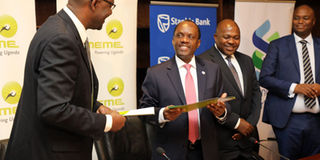Umeme secures Shs258 billion syndicated loan for investment

Loan. Left to right: International Finance Corporation’s country manager Manuel Moses, and Umeme board chairman, Patrick Bitature exchange signed copies of the syndicated loan agreement yesterday. Looking on is Umeme’s managing director Selestino Babungi. PHOTO BY CHRISTINE KASEMIIRE
What you need to know:
- Loan. The loan was an aggregate of $28m from IFC, $10m from FMO, $16m from Standard Chartered Bank and $16m from Stanbic bank.
- The power utility, which currently has 1.4m households connected to the grid plans to accelerate electricity connections to 2m households and reduce energy losses to 13 per cent by 2025.
With only six years left to the end of its concession, Umeme has secured a $70m (Shs258b) syndicated loan from the International Finance Corporation (IFC), Dutch Development bank FMO, Stanbic and Standard Chartered Bank.
Speaking in Kampala yesterday, Umeme chairman, Mr Patrick Bitature said the loan would partly be used to undertake capital investments to evacuate electricity from Uganda’s newest dams.
“The planned investments are aimed at expanding the network to uptake the new generation, improve reliability and create access,” he said.
Investments
Umeme also said the loan would be utilised to prioritise investments in five other areas including extending power to industrial parks, upgrading its network, building the backbone on which more electricity connections will be supplied, accelerate prepayment metering and reducing energy losses.
“You are going to see investments around Najjera, Mukono, Kiwatule to Gayaza area including building substations, switch stations and upgrading the lines. You are also going to see a lot of investments in building the backbone on which we shall connect the 2 million customers,” Mr Selestino Babungi, Umeme’s managing director explained.
This follows continued complaints by the public about the rampant outages in the areas of Ntinda, Najjera, Kyaliwajjala and Kiwatule among others.
The justification, Umeme says is that the areas have grown in regard to population and investments beyond the installed capacity that was set up to serve them (areas) before.
The power utility, which currently has 1.4m households connected to the grid plans to accelerate electricity connections to 2m households and reduce energy losses to 13 per cent by 2025.
Currently, energy losses stand at 16.9 per cent but commercial losses which are as a result of illegal connections and according to Umeme are almost 5 per cent, are a big disservice to the country.
Postpaid metering
In addition, Umeme is planning to shift 230,000 customers currently on postpaid metering to prepaid metering, a system that has enabled the company collect more than 90 per cent of its electricity bills.
Views on Murchison Falls
Commenting on the controversial proposed give-away of Murchison Falls to build a hydro power dam, Mr Bitature said Murchison Falls should be the very last resort if there is no other plan of growing Uganda’s generation capacity.
He was also quick to say it is not yet time to let go of this spectacular icon.
“Maybe not Murchison. Let’s look at other alternatives if we can. But let’s leave the space open for government to do feasibility studies to decide the best way forward,” he said.
Concession delay
The loan was an aggregate of $28m from IFC, $10m from FMO, $16m from Standard Chartered Bank and $16m from Stanbic bank.
Mr Manuel Moses, IFC’s country manager, said delayed commitment for extension of Umeme’s concession by government has affected the terms at which the loan was disbursed.
“We as lenders would have loved to give Umeme flexibility of a longer tenure but we have to be guided by the life of the concession. If it is extended before that, we shall handle how to increase the flexibility on how we can give them a longer tenure,” he said declining to reveal the particular terms of the loan.
The finance minister earlier this year asked the electricity subsector stakeholders to conclude negotiations for the extension of Umeme’s concession.
On whether the power distributor cannot finance its own investments, Mr Babungi explained that of the $600m the company has invested since 2005, about $265m was debt financed while $335m was shareholder equity.
He added that the $70m is only complementary.




